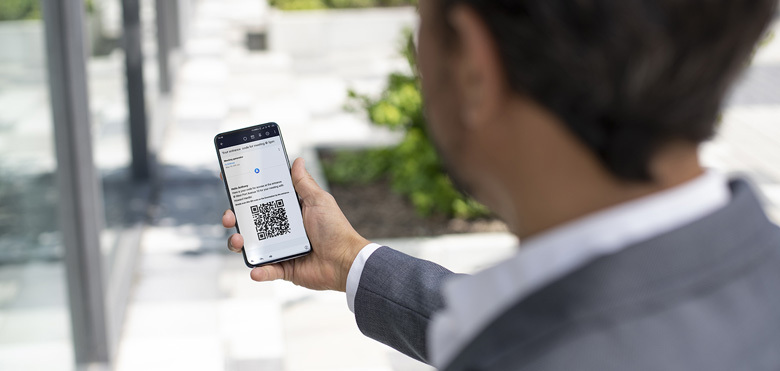QR codes for smart, cost-effective access control
Created in the mid-1990s, QR codes* have become increasingly prominent over the past few years, particularly in industries where low-touch solutions have been required.
Within access control systems, traditional plastic cards are still prevalent as credentials. However, these can be lost or shared between visitors, making it difficult to control and monitor who is getting access to your premises.
In contrast, using QR codes as credentials can be a more secure and efficient way to control access to the business and premises, and have the added environmental benefit of reducing the need for plastic cards. In addition, with the emergence of ‘dynamic’ QR codes, their level of security is comparable, if not better, than plastic cards.
QR codes in access control systems
A QR (‘quick response’) code is a type of two-dimensional barcode that stores data that can be read and processed by the camera in a smartphone or a dedicated reader. Given its ability to store more data than a standard one-dimensional barcode, as well as its flexibility, QR codes are a good option for usage as credentials in an access control system, where the QR code scanner becomes the reader.
Managing a QR code as a credential in an access control system is quite straightforward compared with traditional cards. The system can quickly and easily generate a unique QR code for any individual, which can be set to allow access for a limited time period and number of uses, and entry to specific doors or areas of the building.
Once the QR code has been generated, it can be emailed directly to the recipient (or cardholder) for them to display on their phone or print out if required. This can then be presented to the QR code reader, which scans it and forwards the data to the access control system to confirm the access rights. In some cases, a camera or video intercom at the door doubles as the QR code reader, thereby serving multiple functions.
Enhanced security: dynamic QR codes
A traditional QR code is static, and cannot be changed or updated once created and distributed. This also means it is easy to copy, making less ideal for high-security demands. In these cases, having a dynamic QR code is the ideal solution. A dynamic QR code can be updated and changed even after being created and distributed, while at the same time keeping all the aforementioned benefits of a QR code-based access control solution.
Dynamic QR code-based solutions remove the security risk of credential copy, since a screen copy, photocopy, or even a video recording of the dynamic QR code will not work. Combining it with a multi-factor authentication solution, such as a PIN entered at the same time as the dynamic QR code is scanned, will further increase the security level of the QR code-based access control solution.
Why QR codes for access control?
In addition to the security benefits, there are a number of reasons why organizations would choose QR codes over traditional plastic cards for access control:
Cost-effective
Thanks to the virtualized credential option, a QR code is a cost-effective access control solution compared with the traditional physical card or key fob-based access control solution. It not only reduces the costs of purchasing, handling, printing, distributing, and disposing of physical credentials but also saves the cost of installation, since you can utilize existing video intercoms or cameras as the QR code reader. The organization can simply install a QR code scanning application which requires fewer components, making the whole solution easy to manage and maintain – ultimately reducing the total ownership cost.
Efficient management of staff and visitors
Using a QR code as the credential can be very helpful for improving the efficiency of managing access control systems. A QR code can be generated, distributed, updated, and revoked in a matter of seconds from anywhere, providing a highly efficient system management solution. It is also very convenient to use, suiting the priorities of the mobile-first workforce.
In a typical situation, an external visitor receives a QR code on their mobile phone, which grants them entry into a facility or parking area without having to stop at the front desk. Another typical scenario is the management of late deliveries when there is no staff present. The supplier, with the QR code already on their mobile device, can simply display it in front of a video intercom or camera to gain access to specific areas at a facility. The use of Dynamic QR codes is ideal in these use cases, where security is ensured through the use of multi-factor authentication, and ensuring against ‘static’ QR codes being copied and used by others than those intended.
Sustainable
A QR code effectively provides a virtual card, removing any requirement of plastic cards or key fobs, or even printed paper, thereby having a positive impact on the environment and carbon emissions.
How QR codes helped a smart building in Germany with access control
A good example comes from Germany, where a digital start-up center faced the challenge of having people with varying access rights. The building, located on a university campus, contained coworking areas that could be used 24/7 by registered individual users, including students and entrepreneurs, and also had offices rented out to start-up businesses. This set-up created unique requirements to provide open accessibility to the building, but also to ensure the security of offices and materials at all times.
A solution with QR codes provided the needed flexibility of changing visitors and varying arrival times. A co-worker could, for example, rent a day pass online, which would include a temporary QR code that granted access to the booked space in the building but no further. The arrival time could be adjusted remotely if necessary. Regular visitors such as students could be set up to only get access during the opening times of the university, while entrepreneurs would have unlimited access to the building (and key cards for doors and elevators indoors).
The QR codes also allowed security operators to track who entered the start-up center and at what time. A feature that provided an overview of the number of visitors and could be useful in case of an alarm to identify who was in the building. Network surveillance cameras on-site could also be used to identify individuals on video if needed.
Combined forces: Enhance QR code access control with network audio and analytics
QR codes help to improve access management in several use cases. Turning access control into a contactless and convenient task adds more efficiency, removes friction, and contributes to a more sustainable approach – with reduced costs for maintaining cards and other physical solutions.
Combining QR codes with an intercom isn’t the only way to enhance access control – video analytics can also play a role. For example, in a vehicle access system, license plate recognition can be used in combination with QR codes. Take a hotel for instance. When booking a room, a guest can provide their car license plate number and receive a QR code which would securely grant access to the hotel parking garage. With the right systems in place, guests could gain access when a camera picks up their license plate.
Adding network speakers can be useful to inform the driver that the access is denied, or that a QR code has expired. An alert can be triggered if necessary, allowing security personnel to intervene directly. If surveillance cameras are integrated into the system, a denied access or an alarm caused by a door that was forced open could also trigger the recording of the area, capturing relevant video evidence.
As contactless solutions grow in popularity, the options to extend solutions are numerous and will only increase in the future. End-to-end, integrated solutions have emerged that allow organizations to incorporate QR codes into their security systems and reap the many benefits of enhanced access control.
Click to find out more about Axis’ Access Control solutions.
Read about 2N’s thoughts about QR codes in access control.
*QR Code is a registered trademark of Denso Wave, inc.



